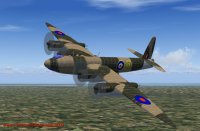Geodetics
During the construction of R.100, Wallis occasionally visited the Blackburn aircraft factory at Brough, and was surprised at the primitive wood-and-canvas methods being used, compared to the elegant lightweight metal structure of his airship. One visitor to Howden was Rex Pierson from the Vickers aircraft factory at Weybridge. The two men got on well, and even before R.100 had flown, Wallis was recruited to move to Weybridge (his move to the aircraft company was not a consequence of the R.101 crash). After a brief spell at Supermarine in Southampton, where Wallis definitely did not get on with R.J. Mitchell, designer of the Spitfire, he settled into applying his expertise in using light alloy construction to fixed-wing aircraft. Wallis and Pierson were the centre of the Vickers-Armstrongs design team – Pierson working on the general layout of the aircraft and Wallis designing the internal structure.
His first complete aircraft structure design was the Vickers M.1/30 torpedo bomber, which used light alloy wing spars inspired by the girder structure of R.100. Test-flown in 1933 by the Vickers test pilot, Joseph “Mutt” Summers, the plane broke up during a flight in November; the aircraft did not go into production.
Around this time, Wallis hit upon a revolutionary structural idea – rather than building an aircraft structure on the conventional principle of a beam, which supports an external aerodynamic skin, he developed a new type of structure which had the structural members formed within the aerodynamic shape itself. This required the structural members to follow the curved outer shape of the fuselage and wings. These members followed geodesic curves in the surface, the shortest distance between two points in the curved surface - this gave the new structure its name, geodetics. By having the curves form two helices at right angles to one another, the geodetic members became mutually supporting, and the overall framework became immensely strong. In addition to being comparatively light and strong, the fact that the geodetic structure was all in the outer part of the airframe meant that the centre was a large empty space, ready to take payload or fuel.
Vickers developed two aircraft for the Air Ministry specification G.4/31 for a general-purpose aircraft – a biplane with a geodetic fuselage and conventional wings, and a monoplane with geodetics in both fuselage and wings (the latter developed by Vickers as a private venture). The monoplane was found to have a far greater disposable load than the biplane, and bending load tests on the monoplane wings were abandoned as they could not be broken on the test rig!
Despite an Air Ministry order for 150 biplanes, Vickers boldly told them they were going to build the monoplanes instead due to its superior performance. This aircraft entered service in 1937 as the Vickers Wellesley, and 176 of the aircraft were built. The massive fuel capacity of the Wellesley saw the aircraft assigned to the RAF’s Long Range Development Unit. In November 1938, three of these aircraft flew from Ismailia in Egypt to Darwin in Australia, a new world record distance of 7,158 miles - an absolute record that stood until broken by an American B-29 Superfortress in 1946.
- It is believed that this distance record still stands for a single-engined aircraft with a piston engine, and also for aircraft flying in formation. If you know that either of these records has been broken, please e-mail us.
As the Wellesleys were under construction, Wallis was working on a larger twin-engined geodetic bomber to specification B.9/32. First flying in 1936, this aircraft became the Vickers Wellington, the aircraft having pushed the original specification from carrying a 1,000lb bomb load for 720 miles up to carrying a 4,500lb bomb load for 2,500 miles. This performance was in excess of contemporary aircraft, and led to the Wellington being the main aircraft used by Bomber Command for the first three years of the war. Even when superseded by four-engined types, it continued in production until 1945 – 11,462 aircraft were built, a total still unsurpassed by any British multi-engined aircraft.
Generally seen as the successor to the Wellington, the Warwick was actually designed at the same time as the production Wellington, and the two aircraft shared around 60% of their structural components. Designed to the same B.1/35 specification as the Avro Manchester, the Warwick was similarly beset with a history of engine development problems, and the first production aircraft was not ready until 1942. By that time, the four-engined heavy bomber was becoming established in Bomber Command, and the Warwick was mainly relegated to air-sea rescue and transport duties; fewer than 1,000 were built.
The final geodetic aircraft - with geodetic structure more complex than on the earlier aircraft - was a four-engined heavy bomber – the Windsor.
The aircraft featured cannons mounted in the rear of the outer engine nacelles which were controlled remotely by a gunner in the rear of the fuselage, and four main landing wheels, one under each engine, and the aircraft could have carried one of Wallis’s ten-ton Grand Slam bombs. First flown in October 1943, three prototypes were built, but the aircraft would not have offered significantly better performance than the Avro Lancaster which was already in service, and the initial orders for several hundred aircraft were cancelled at the end of the war.
Post-war, the higher speeds and higher operating heights, and the need for pressure cabins, meant that fabric-covered geodetics were no longer suitable. Although some early Vickers Viking VC-1 airliners used geodetic wings from the Wellington production line, there would be no further geodetic aircraft.











